Text and photos by Marla Leigh Caplan.
It’s 4:16:13pm according to the computer monitor on the day of my final critique, April 24, 2007. The lights are off and there’s a gray haze emanating from the windows – enough so it’s not totally dark inside. A two-way mirror reflects the long narrow corridor behind me.
Upon entering the studios, 9 panels of black chinoiserie, commercial grade wallpaper printed with a vintage pattern in a gothic style with climbing vines and flowers, hung loosely from the foyer wall. Each panel was nailed at the top and draped to the floor like a curtain, sides curving to expose their seams, scrolling up from the floor. The sense that the wallpaper was coming unhinged felt like a psychological unraveling. Hanging the paper like curtains reiterated the feel of the “Garden Tapestry” piece I installed in the stairwell of ICP, a 9×12 ft reincarnation of the Unicorn Tapestry at the Cloisters.
In the main gallery, I showed five large format images mounted to plexiglas and installed a still-life arrangement on the floor. Resonating with saturated color, shiny objects hung high, they were constructions in which still-life arrangements were photographed in front of other photographs, in a circle of work in which they would then become backdrops for new photographs, each time adding a new layer of time and reflection. The prints on the wall were like windows into a world of my own creation, I overheard someone say.
Proceeding around the gallery to the right, one encountered each photograph at a time and, just before completing the circle, came to the set installed on the floor, composed of moss, dried blue delphinium, shallots and brussels sprouts, purple potatoes sprouting purple sprouts, miniature purple artichokes, pink and deep pink peonies, strawberries, orchid blossoms, an eggplant, sage, dried rose petals, a red beet, fresh delphinium, dried raspberries, radishes, edible organic flowers, dried purple lilies, dirt, stones, broken glass, a hanging plant, a ponytail palm tree, a dead orchid root, orphaned pussywillow catkins, and rainbow chard. Inserted into the decayed landscape, the remains of previous sets, I filled a large round vase with peonies, a strange plant with languorous red blossoms that reminded me of macramé, and an orchid variation, also in deep red. I installed the photograph behind the set as if it were the central object of worship in a devotional piece.
In terms of the act of collecting and re-arranging the still life, I think of Wolfgang Laib, whose work involves the gathering and slow accumulation involved in the ritualistic practice of creating phenomenological color fields out of organic products. I first learned of Laib’s work from an article in the New York Times art section entitled, “The Impenetrable that Leads to the Sublime,” an account of Laib’s retrospective exhibition at the Hirschhorn Museum in D.C. in 2001. The point of his installation work is to transform in some way the viewer’s perception of their environment.
An arrangement of palm leaves and deep purple calla lilies, placed in a round glass bowl on top of a black and metal case stenciled with “ICP” across the side was adjacent to the remains, quietly placed in the corner of the room as a tribute to their dying beauty. A long black electrical cord snaked from the outlet on the wall next to the case and across the floor in front of the piece connecting two black lamps and making a border around the installation.
In the gallery, the viewer took on the position of the photographer, standing between the installation and the photographs of the installation with the lights intruding in the middle of the room. The hum of electricity from the floor lamps illuminating the set implied a limited sense of time, the potential for the strobe to freeze an instant and the idea of decay in the accelerated aging of the plants under the hot lights. I realized I needed to pay the same kind of attention to the electrical cords that I did the plant forms. The inclusion of photographic equipment was meant to expose the artifice at work in the still life – someone in class said the lights in the set were like the microphones in a church. I felt the honest acknowledgement of visual amplification and artificiality in the studio set up was an important counterpoint to the deliberate disorientation going on in the photographic constructions.
Thinking about the exposure of artifice in my own work, I am reminded of a piece I saw at the Berkeley Art Museum in the summer of 1998 and how it brought up issues of artifice and framing that I hadn’t yet attempted to make sense of and that would later become important. Dawn Fryling’s “Untitled, 1991” installation at the Berkeley Art Museum consisted of six equally-sized glass paned window frames and a steel halogen lamp about two feet in diameter. The frames were evenly spaced so that they leaned against the length of the concrete wall at a 30-degree angle. Their shadows made twelve vertical stripes on the concrete and extended out across the intersecting floor. The frames were painted with black enamel that picked up the glare from a halogen lamp approximately eight feet from the wall. The lamp rested on a portable stand that appeared to double as a carrying case for the electrical cord coiled on the floor to the right of the lamp. All the while, the work was accompanied by the incessant buzz of the halogen lamp. The light brought to attention the detailed grain of the cement wall behind the frames, the shadows from the glass panes, and the sheen on the gallery floor. A closer look revealed nine punctures in the concrete walls. To what extent the architecture of the museum influenced the realization of the installation was of foremost concern. The installation, six window frames and a light source, was characterized by at least two types of division. The frames immediately raised questions about borders where the opposites involved (inside/outside, observer/observed) changed places. What is inside the work of art?
In this instance, the work at hand was the frame, built by the passerby, the neighboring exhibits, the architecture of the museum, and in short, by all of the sounds, smells, and sights that affect the experience of viewing a work of art – broader still, in the sense in which the frame was a relation to a particular time and place. The frame, as a set, appeared and disappeared behind the scene it created. The six frames and single halogen lamps exhibited a clearing where what was lit up was nothing more than the open space of possibility. The piece stayed silent by eliminating artful language that pointed and made reference by means of figuration and symbol. Reversing a hierarchy that values the more enduringly present as the more real, and thus visually, foreground over background, this piece framed nothing in such a way that nothing is framed, and so we turn to the frame itself.
In Fryling’s work, reflection involved the viewer in the work physically and psychologically. The work changed visibly as the passerby passed by and was caught in the reflection. The actual work was altered by the viewing – at the same time resisting and reflecting the changing situation. The mirrored surface recorded the observer and the observed simultaneously. I like the kind of ambiguity in pictures that collapse inside and outside spaces, foreground and background to one plane, as if all of experience could be layered in one moment, a compression of time collected, layered, mirrored, doubled, repeated, and so on to infinity.
In the absence of visual noise, everything else is amplified. In that silence I heard the buzzing electric generator, the register bell tolling in the gift shop downstairs, and all the various incidentals that frame life. The absence of the subject was simultaneously an erasure and a window of opportunity. The light source laid bare was the real object of reflection in this piece.
I saw Yves Klein’s “Table Bleue” at a show called, “Art & Alchemy: Materialization of Sensibility” at Leslie Tonkonow Gallery, New York in October 2006. A plexiglas case filled with indigo pigment, the piece struck me in its materiality and its impossibly vibrant color. The ideas articulated by the show’s curator, Klaus Ottmann (who also happened to have curated the Laib retrospective at the Hirschhorn) described Yves Klein as “liberating matter and color as the materialization of sensibility.” To me, this piece more than any other in the show epitomized the idea of the spiritual force of the materials themselves.
During this afternoon’s critique, talk of nature as a product came up in relation to the idea of visual consumption suggested by the highly finished surface of the framed pieces and the inherent reproductive nature of photography itself. The evolution of my still-life work has culminated in the recreation of the setup to expose the process, a reproductive cycle in which the photograph is used to create the set which is used to create another new photograph and so on. Reiteration of objects in the images and sets results in a doubling effect that leads to the idea of parody but also begins to establish a formal language and iconography. Meaning is created through opposition and difference but also through sameness and repetition.
“Garden Tapestry,” was a 9×12 foot site-specific installation that addressed issues of appropriation and authorship in my work for the first time. Exaggerating the formal iconography of the 16th century Unicorn Tapestry, I set out to overwhelm the viewer with a manic design, using large format photographic details of the original to create a new pattern that I printed onto silk and hung in the stark white modernist staircase descending from the glass pavilion into the school of the International Center of Photography in midtown Manhattan. Implicit in the rhetoric and ideology of nature as decoration are the notions of domination, submission and control. This piece was largely about claiming and altering the experience of the space through a strategy of visual seduction and aggressive aesthetic imposition.
The kudzu pictures made around the same time introduced a more elaborate narrative about control and territory in my landscape work. I selected the kudzu vines as a subject for their excessively spreading shapes, for their immense detail and intricate forms. A purple haze rendered the aura of the vines visible from a distance, an abundant reminder of nature’s generosity as well as its authority. Reduced to their bare shapes, the vines were also reminders of death. I saw the vines as translations of the intricate web we traverse as individuals in the larger realm, as if they represented the structure of being and time in the patterns they yield and in their mystery, which sometimes seemed so explicit and other times so completely veiled. The density of the forest and it’s perceived impenetrability, this notion of a stubborn anti-narrative, is contradicted by the generosity of detail in a landscape lush and alive with visual information.
Thomas Struth’s “Paradise” series was extremely influential in my desire to achieve works of grand scale and technical mastery with the ability to completely subsume the viewer’s field of vision. At Struth’s 2003 retrospective at the Metropolitan Museum, New York, I stood in awe of that work, overcome by its immediacy. The only other time I remember having such an experience was the first time I saw a Rothko in person.
In an Artforum interview in 2002 about his “Paradise” pictures, Struth describes unconscious places of the material worlds like dream spaces, with abrupt disturbances and inexplicable deviations completely unique and yet inextricably tied to the rest of nature – absolutely literal and yet completely evasive:
They are “unconscious places.” The photographs taken in the jungles of Australia, Japan, and China, as well as in the California woods, contain a wealth of delicately branched information, which makes it almost impossible, especially in large formats, to isolate single forms. One can spend a lot of time in front of these pictures and remain helpless in terms of knowing how to deal with them.
I think I also responded to his deep sense of denial. Struth continues:
There is no sociocultural context to be read or discovered…the jungle pictures…emphasize the self. Because of their consistent “allover” nature, “Paradise” numbers IX and IV could be understood as membranes for meditation. They present a kind of empty space: emptied to elicit a moment of stillness and internal dialogue. You have to be able to enjoy this silence in order to communicate with yourself–and eventually with others. I didn’t want to portray a specific place, [or a] specific forest. Rather I was trying to feel within its primeval branchings the moment of beginning that once was the world. It’s about the experience of time as well as a certain humility in dealing with things. It’s a metaphor for life and death.
It’s 8:01pm Wednesday evening one week later. The silvery light is sifting down the windowsill in an otherwise dark studio. I am in front of the open window across from the space I share with Lara, looking out towards the glittery Citibank building. The plants rest in silhouette on the filing cabinet behind me. A cool breeze reminds me that I am physically alive. Outside twilight is deepening, a cerulean glow spreading along the horizon where the sun has already set. I need to think about clearing this space out and moving on, but I’m not making much progress.
I saw the exhibition “The Perfect Medium” at the Metropolitan Museum, New York in the fall of 2005. The show was an exhibition of mid-19th century photography attesting to the existence and triumph of the spirit, documenting otherworldly manifestations, ghosts and mediums, through the re-materialization of the dead. Much of the work presented was “trick” photography, frequently employing double exposures and constructed scenarios. The work itself was precious, small, having the aura of something old, and the accumulated feel of history. The objects in the show had a ritualistic, talismanic sensibility. The show made an impression on me in thinking about the possibility of constructed imagery in a medium loaded with the presumption of truth and evidence.
In my recent work, I have been engaged in an obsessive investigation into notions of artifice and the construction of beauty. The photographs in the Vanitas series are sets in which elaborate and eventually rotting botanical arrangements are installed in front of various photographic backdrops, mirrors, and windows. The images simultaneously look inside and out, with elements of reflection confusing the distinction between interior and exterior spaces and presenting multiple points of view. I am interested in a certain ambiguity in pictures where the collapse of foreground and background onto one plane suggests our perceptions of the world can be layered in one moment. Testing assumptions of belief and photographic truth, the images continue to give evidence of scenarios that never actually existed. They are absolutely literal, and yet continue to resist a precise meaning.
For additional information and photographs visit Marla Leigh Caplan web site.

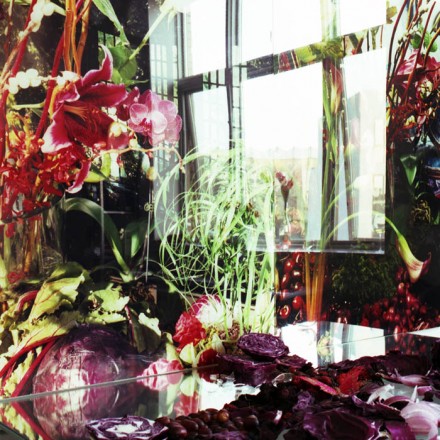
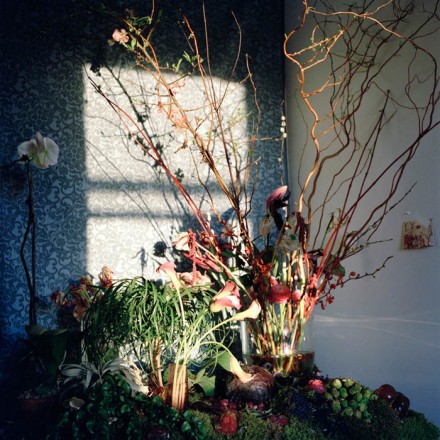
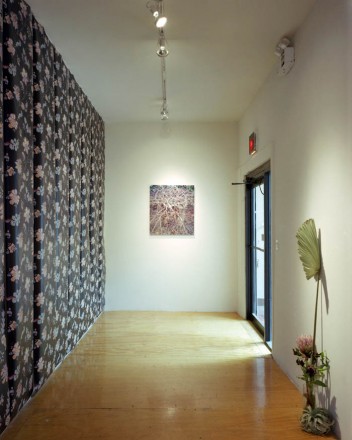
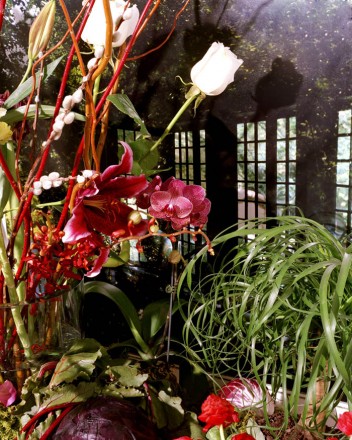
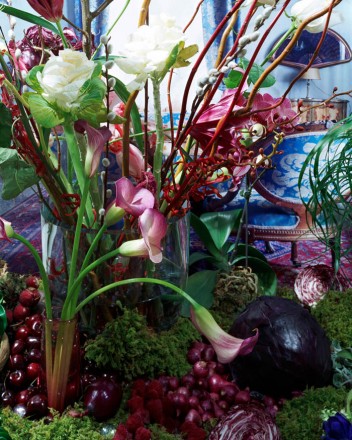
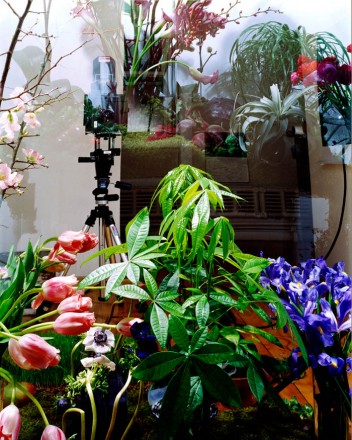
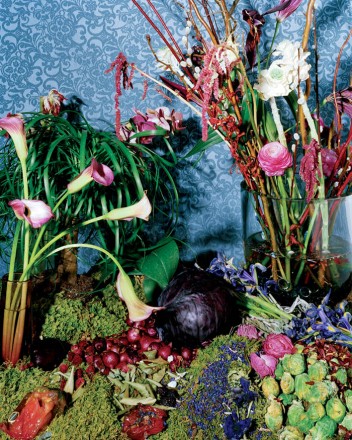
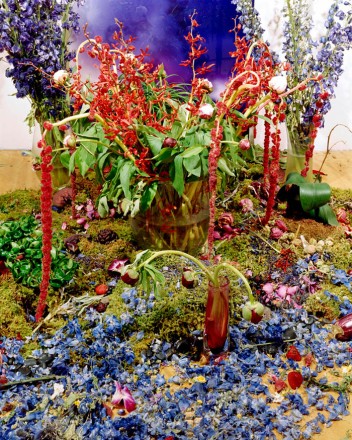
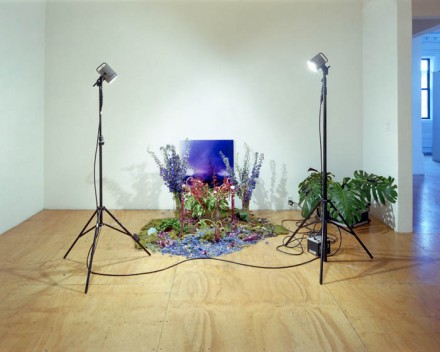
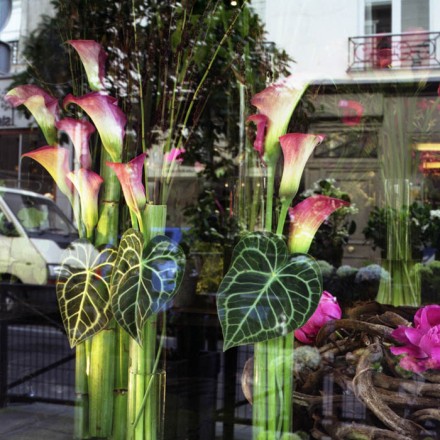
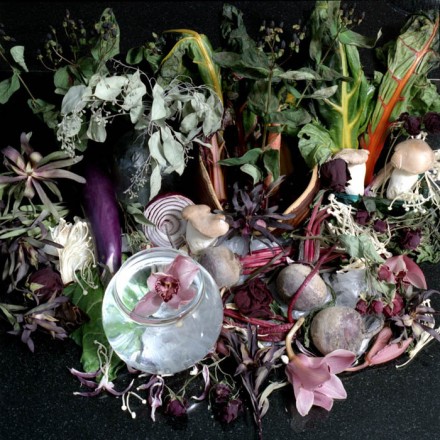
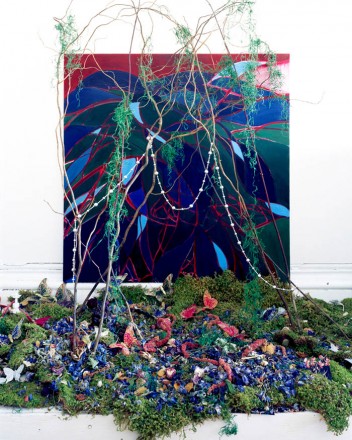
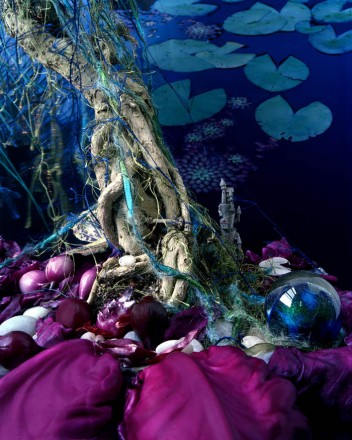
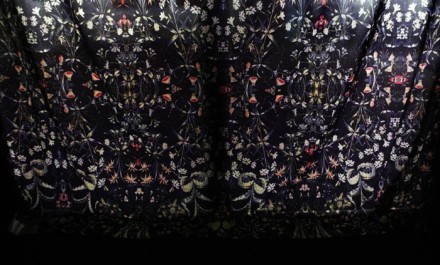
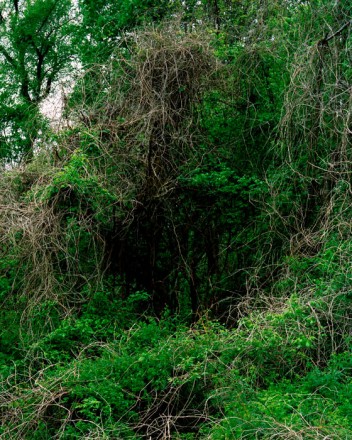
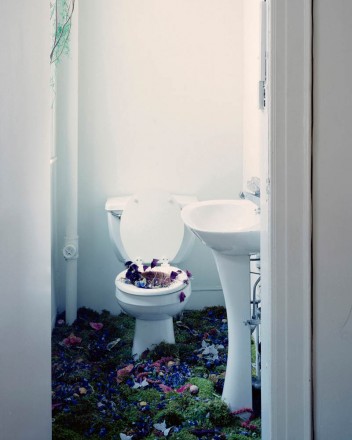
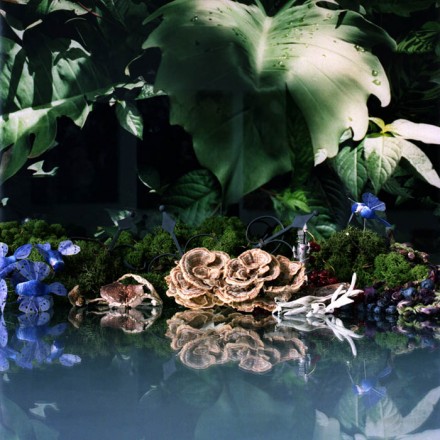
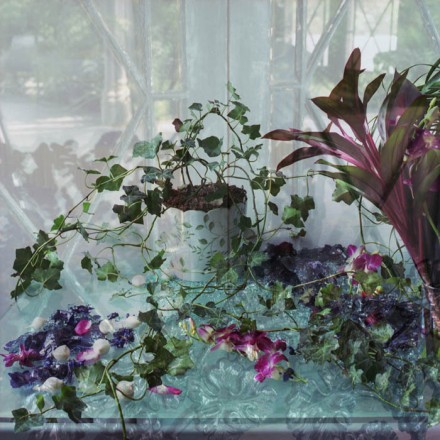
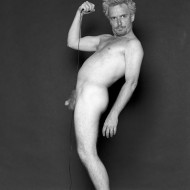
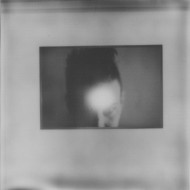
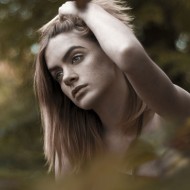
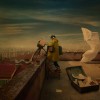
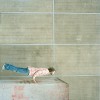





























Your photographs are dreamy & beautiful. I’d like to crawl inside your head for a day!
You can also subscribe to this post comments RSS feed.